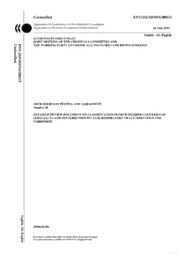
Detailed review document on classification in OECD member countries of substances and mixtures which cause respiratory tract irritation and corrosion [electronic resource] PDF
Preview Detailed review document on classification in OECD member countries of substances and mixtures which cause respiratory tract irritation and corrosion [electronic resource]
Unclassified ENV/JM/MON0(2003)2 OrganisationdeCooperationetdeDeveloppementEconomiques OrganisationforEconomicCo-operationandDevelopment 24-Mar-2003 ENVIRONMENTDIRECTORATE English-Or.English JOINTMEETINGOFTHECHEMICALSCOMMITTEEAND EN THEWORKINGPARTYONCHEMICALS,PESTICIDESANDBIOTECHNOLOGY Unclassified V/JM/MON 0(2003)2 OECDSERIESONTESTINGANDASSESSMENT Number40 DETAILEDREVIEWDOCUMENTONCLASSIFICATIONINOECDMEMBERCOUNTRIESOF SUBSTANCESANDMIXTURESWHICHCAUSERESPIRATORYTRACTIRRITATIONAND CORROSION m 3 K’ C JT00141386 w 35393*, DCoomcpulmeetnetdcoocmupmlecnttdiasvpaoinliabbllcesounrOOLLIISSidnaintssosroingifnoarlmfaotrmda'toriginc ENV/JM/MON0(2003)2 OECDEnvironment,HealthandSafetyPublications SeriesonTestingandAssessment No.40 DETAILEDREVIEWDOCUMENTONCLASSIFICATIONINOECDMEMBER COUNTRIESOFSUBSTANCESANDMIXTURESWHICHCAUSERESPIRATORY TRACTIRRITATIONANDCORROSION EnvironmentDirectorate OrganisationforEconomicCo-operationandDevelopment March2003 2 ) ENV/JM/MONO(2003)2 ALSOPUBLISHEDINTHESERIESONTESTINGANDASSESSMENT: No.1, GuidanceDocumentfortheDevelopmentofOECD GuidelinesforTestingofChemicals(1993;reformatted1995) No.2, DetailedReviewPaperonBiodegradabilityTesting (1995) No.3, GuidanceDocumentforAquaticEffectsAssessment (1995) No.4, ReportoftheOECD WorkshoponEnvironmental Hazard/RiskAssessment(1995 No.5, Report oftheSETAC/OECD Workshop onAvian ToxicityTesting(1996) No.6, ReportoftheFinalRing-testoftheDaphniamagna ReproductionTest(1997) No.7, GuidanceDocumentonDirectPhototransformationof ChemicalsinWater(1997) Naboo.u8t,NewReIpnodrutstorifatlheChOeEmiCcDalsWoArsksseshsompenotn(S1h9a9r7i)ngInformation No.9, GuidanceDocumentfortheConductofStudiesof Occupational Exposure to Pesticides during Agricultural Application(1997) No.10, ReportoftheOECDWorkshoponStatisticalAnalysis ofAquaticToxicityData(1998) No.11, DetailedReviewPaperonAquaticTestingMethodsfor PesticidesandindustrialChemicals(1998) fNoor.G1e2r,mDCeetlaliMluetdagReenviiceiwtyDioncOuEmeCnDtMoenmbCelarssCiofuinctartiioens(S1y9s9t8e)ms fNoor.Se1n3,sitiDseitnagiSluebdstRaenvcieeswinDoOcEuCmeDnMteomnbeCrlaCsosuinfitcraiteison19S9y8s)tems fNoor.E1y4e,IrDreittaatiiloend/CRoervrioseiwonDioncOumEeCnDtMoenmbClearssCiofuicnattriioensS(y1s9t9e8m)s fNoor.Re15p,rodDuecttaiivleedToRxiecviiteywinDOocEuCmDenMtemobnerClaCsosuinftirciaetsio(n19S9y8s)tems fNoor.Sk16i,nIrDreittaaitlieodn/RCoervrioeswionDoincuOmEeCntDoMnemCbleasrsiCfoiucnattriionesS(y1s9t9e8m)s 3 ) ) / ENV/JM/MONO(2003)2 NExoi.st1i7n,gEInndvuisrtornimaelntCahlemiEcxaplossurienOAsEsCesDsmeMnetmbSetrrateCgoiuenstrfioesr (1999) No.18, ReportoftheOECDWorkshoponImprovingtheUseof MonitoringDataintheExposureAssessmentofIndustrial Chemicals(2000) No.19, Draft Guidance Document on the Recognition, AssessmentandUseofClinicalSignsasHumaneEndpointsfor ExperimentalAnimalsusedinSafetyEvaluation(1999) No.20, RevisedDraftGuidanceDocumentforNeurotoxicity Testing(inpreparation) No.21, DetailedReviewPaper:AppraisalofTestMethodsfor SexHormoneDisruptingChemicals(2000) No.22, GuidanceDocumentforthePerformanceofOut-door MonolithLysimeterStudies(2000) No.23, GuidanceDocumentonAquaticToxicityTestingof DifficultSubstancesandMixtures(2000) No.24, Guidance Document on Acute Oral Toxicity Testing(2001) No.25, DetailedReviewDocumentonHazardClassification SEyxsptoesmusrefoirnOSpEecCiDficMseTmabregretCoOurngtarniesSy(s2t0e0m1i)cToxicityRepeated No.26, RevisedAnalysisofResponsesReceivedfromMember CountriestotheQuestionnaireonRegulatoryAcuteToxicity DataNeeds(2001) No27, GuidanceDocumentontheuseoftheHarmonised SystemfortheClassificationofChemicalswhichareHazardous fortheAquaticEnvironment(2001 No28, GuidanceDocumentfortheConductofSkinAbsorption Studies(inpreparation) No29, Draft Guidance Document on Transformation DissolutionofMetalsandMetalCompoundsinAqueousMedia (2001) No30, DetailedReviewDocumentonHazardClassification SystemsforMixtures(2001 No31, DetailedReviewPaperonNon-GenotoxicCarcinogens Detection:ThePerformanceofIn-VitroCellTransformation Assays(inpreparation) 4 ) ENV/JM/MONO(2003)2 No.32, GuidanceNotesforAnalysisandEvaluationofRepeat- DoseToxicityStudies(2000) No.33, Harmonised Integrated Classification System for Human Health and Environmental Hazards of Chemical SubstancesandMixtures(2001) No.34, GuidanceDocumentontheDevelopment,Validation andRegulatoryAcceptanceofNewandUpdatedInternationally AcceptableTestMethodsinHazardAssessment(inpreparation No.35, Guidancenotesforanalysisandevaluationofchronic toxicityandcarcinogenicitystudies(2002) No.36, ReportoftheOECD/UNEPWorkshopontheuseof Multimedia Models for estimating overall Environmental Presistence and long range Transport in the context of PBTS/POPSAssessment(2002) No.37,DetailedReviewDocumentonClassificationSystemsfor SubstancesWhichPoseanAspirationHazard(2002) No.38,DetailedBackgroundReviewoftheUterotrophicAssay SthuemmOaErCyDofTtahsekAvFaoilracbeleoLnitEenrdatoucrreinineSDuipsprourptteorfsthTeesPtrionjgectanodf Assessment(EDTA)toStandardiseandValidatetheUterotrophic Assay(2003) No.39,GuidanceDocumentonAcuteInhalationToxicity Testing(inpreparation) ©OECD2003 Applicationsforpermissiontoreproduceortranslateallorpartofthismaterialshouldbemadeto’.Head ofPublicationsService,OECD,2rueAndre-Pascal,75775ParisCedex16,France 5 ENV/JM/MONO(2003)2 ABOUTTHEOECD TheOrganisationforEconomicCo-operationandDevelopment(OECD)isanintergovernmental organisationinwhichrepresentativesof30industrialisedcountriesinNorthAmerica,Europeandthe Pacific,aswellastheEuropeanCommission,meettoco-ordinateandharmonisepolicies,discussissuesof mutualconcern,andworktogethertorespondtointernationalproblems.MostoftheOECD'sworkis carriedoutbymorethan200specialisedCommitteesandsubsidiarygroupscomposedofMembercountry delegates.ObserversfromseveralcountrieswithspecialstatusattheOECD,andfrominterested internationalorganisations,attendmanyoftheOECD'sWorkshopsandothermeetings.Committeesand subsidiarygroupsareservedbytheOECDSecretariat,locatedinParis,France,whichisorganisedinto DirectoratesandDivisions. SafetyPrTohgerawmomrek.oAfsthepaOrtECofDirtselawtoerdktoocnhecmhiecmailcaslafetteystiisngc,artrhieedOouEtCiDnthhaesEnivsisruoendmesnetve,raHleaClotuhnacnild DGeuciidsainocnesaDnodcuRmeecnotmsmenanddattieocnhsnic(athlerfeoprormtesr.lTeghaellybebsitndkinngowonnmoefmtbheesrecopuunbtlriiceast)i,onass,wtehlelaOsEnCuDmerToeusst Guidelines,isacollectionofmethodsusedtoassessthehazardsofchemicalsandofchemical pwriledplairfaet,ioannsd.aTchceusmeulmaettihoondasncdovdeegrrtaedsattsifoonripnhytshieceanlvainrdoncmheenmti.cTalheprOopEerCtDiesT,esetffGeuctisdeolninheusmaarnerheecaolgtnhiasnedd world-wideasthestandardreferencetoolforchemicaltesting. (includingMorteheinfToersmtatioGnuidaebloiuntest)heEinsviraovnamielanbtl,eHeoanlthtahnedSOafEeCtDy'PsrogWroarmlmdeaWndidietspuWbelibcatisointse http://www.oecd.org/ehs/. TheEnvironment,HealthandSafetyProgrammeco-operatescloselywithotherinternational organisations.ThisdocumentwasproducedwithintheframeworkoftheInter-OrganisationProgrammefor theSoundManagementofChemicals(IOMC). TheInter-OrganizationProgrammefortheSoundManagementofChemicals(IOMC)was eOsrtgaabnliissahteidonisn),1f9o9l5lobwyingUNrEecPo,mmIeLnOd,atFiAoOns,mWaHdOe,byUtNhIeD1O992anUdNthCeonOfeErCeDnce(tohneEPanrvtiircoinpamteinntg aoOfrngdcahnDeiesmvaietcliaoolnp.msaefTnehttyet.opusUrtprNeoInsTgetAhoRfentjhcoeoi-InoeOpdeMrtCahteiisoIntoOaMpnrdCoimniocntree1a9cs9oe7-oinrttodeirnbnaeatctioioomnneaolftcthhoee-ospreodvliiencniatethsioaPnanrditniatcchtiiepvaifttiiienelsgd pursued bytheParticipating Organisations,jointly orseparately,toachievethesound managementofchemicalsinrelationtohumanhealthandtheenvironment. 6 ENV/JM/MON0(2003)2 Thispublicationisavailableelectronically,atnocharge. ForthecompletetextofthisandmanyotherEnvironment, HealthandSafetypublications,consulttheOECD’s WorldWideWebsite (http://www.oecd.org/EN/document/0..EN-document-519-14-no-21-1080-0,00.htmll orcontact: OECDEnvironmentDirectorate, Environment,HealthandSafetyDivision 2rueAndre-Pascal 75775ParisCedex16 France Fax:(33-1)45241675 E-mail:[email protected] 7 ENV/JM/MONO(2003)2 DETAILEDREVIEWDOCUMENTONCLASSIFICATIONINOECDMEMBER COUNTRIESOFSUBSTANCESANDMIXTURESWHICHCAUSERESPIRATORY TRACTIRRITATIONANDCORROSION SCOPEANDDEFINITIONS Scope 1. Thisendpointcoverssubstances[andpreparations]thatcauseirritationoftheupperrespiratory tractinhumans. DESCRIPTIONOFTHECLASSIFICATIONSYSTEMSINPLACE TheEUsystem(includingSlovenia): 2. ThedevelopmentoftheRphrase,R37,IrritatingtorespiratorysystemwithintheEUisdetailed inAppendix1.Thecurrentcriteriaareasfollows: R37:Irritatingtorespiratorysystem: Isassignedtosubstancesandpreparationswhichcauseseriousirritationtotherespiratory systembasedon: a)practicalobservationinhumans b)positiveresultsfromappropriateanimaltests CommentsregardingtheuseofR37: Ininterpretingpracticalobservationsinhumans,careshouldbetakentodistinguishbetween effectswhichleadtoclassificationwithR48(1)fromthoseleadingtoclassificationwithR37. ConditionsnormallyleadingtoclassificationwithR37arereversibleandusuallylimitedtothe upperairways. Positiveresultsfromappropriateanimaltests'21mayincludedataobtainedinageneraltoxicity test,includinghistopathologicaldatafromtherespiratorysystem.Datafromthemeasurementof experimentalbradypnea(3)mayalsobeusedtoassessairwayirritation.’ (1>R48=Dangerofseriousdamageafterrepeatedorprolongedexposure. >2>Appropriateanimaltestscouldincludeanacuteinhalationtoxicitystudy,arepeated-exposure inhalationstudy. <3>The‘Alarieassay’. 3. Asageneralobservation,historically,forExistingSubstancesthedatathatwereusedasabasis forclassificationwithR37weremainlybasedonhumanexperience.However,inrecentyearstherehas beenanincreasingrelianceontheuseofinformationfromanimalstudies.ForNewSubstances,itishighly unlikelythattherewillbehumanexperienceinformation,henceclassificationisbasedonothersourcesof informationsuchasexperimentalstudiesinanimals,orpredictionbasedoncorrosivity(toskin/eyes). ENV/JM/MONO(2003)2 4. Formixtures,thehealtheffectdatarequiredforclassificationandlabellingmaybeobtainedby theapplicationoftestmethodsindicatedabove.Classificationmayalsobeobtainedbyapplicationof methodsindicatedinPartBofDirective1999/45/EC(‘ThePreparationsDirective’),‘Concentrationlimits tobeusedinevaluationofhealthhazards’.Thissetsoutspecificconcentrationlimitsforgaseousandnon- gaseousmixtures(orpreparations).Inshort,amixturemaybeclassifiedas‘R37,Irritatingtothe RespiratoryTract’ifthatmixturecontainsmorethanaspecifiedpercentageconcentrationofasubstance thathasbeenclassifiedas‘Corrosive’(seeAppendix2). TheUSSystem 5. IntheUSA,thereisnoclassificationspecificallyforthisendpoint;itishandledasatargetorgan effect,basedmainlyuponhumanexperience.IntheUSA,fortheOccupationalSafetyandHealth Administration(OSHA)andConsumerProductSafetyCommission(CPSC),targetorganeffectsleadto identificationofthespecificorganonthelabel.Thevariousprecautionarystatementsandstatementsof treatmentcanbeorganizedinaspecificmanner.Hence,respiratorytractirritationiscoveredinthis manner. TheCanadianSystem p6.rovisionsThfeor“CcahnraondiicantoxWicorekfpfelcatcs”e.HAazcahrrodnoiucstoMxaitceerfifaelcstisIndfeofrimnaetdioasnanSyasdtveemrse(eWffHeMctISon)thienchleuadletsh ofapersonortestanimalthatdevelopsovertime,followingasingleexposuretoatoxicsubstance,orafter prolongedorrepeatedexposuretoatoxicsubstanceunderconditionsthatdonotproducethesameeffect fromasingleexposure.Adversehealtheffectsinthiscategoryincludelife-threateningorserious impairmentofbodyorgansandthecardiovascularornervoussystem. Respiratorytractirritationwould fallintothishazardclass. ThecriteriaforsubstancesortestedmixturesforthishazardclassaredetailedinAppendix3. UNTransportofDangerousGoods 7. IntheUNtransportregulationsirritationoftherespiratorysystem(RTI)iscoveredindirectlyvia thesubsidiarycorrosiveriskfortoxicgases.Toxicgasesare: Gases - whichareknowntobesotoxicorcorrosivetohumansastoposeahazardtohealth;or —orwhleiscshthaarenp5r,0e0s0ummeld/mto3b(epptmo)x.icorcorrosivetohumansbecausetheyhaveanLC50valueequalto Gasesmeetingtheabovecriteriaowingtotheircorrosivityaretobeclassifiedastoxicwitha subsidiarycorrosiverisk. Mixturesofgases: Abceomgdapesosntmerinuxctttsuirvoeefhttaohsetamhiesxutbssukiirnde,iaiseryyeeqrsuiaskolrotfomcuoorcrorlouessssivtimhteaymnwb5rh,ae0nn0e0tshmelom/rimxw3th(ueprnepmit)shkewnhLoeCwnn50tbhveyaLlhCuue5m0aoifnstechxaeplcecurloiaretrneocdseibvtyeo aformulausingmolfractionsandLC50values. 9 : ENV/JM/MONO(2003)2 APPENDIX1:DEVELOPMENTOFR37,IRRITATINGTOTHERESPIRATORYSYSTEM WithintheEU,thefirstgeneraldefinitionof"irritating"inDirective67/548/EEC(27June1967)was recordedas"Non-corrosivesubstancesandpreparationswhich,throughimmediate,prolongedorrepeated contactwiththeskinormucousmembrane,maycauseinflammation".TherespectiveR-(isk)phrasewas initiallyR84=Irritatingtoskin,eyesandrespiratorysystem. Directive76/907(14July1976):Creationofnew(separate)Rphrase:R37=Irritatingtorespiratory system. Directive83/467(16Sept. 1983):Forthefirsttimeacriterionwasintroduced:"Substancesand preparationswhichcauseseriousirritationtotherespiratorysystem,basednormallyonpractical observation."Thismeansthatatthattimedatafromanimalexperimentswerenotregardedtobeusefulin classificationforthisendpoint. Directive93/21/EEC(27April1993):R37isslightlymodified.Newcriteria:"Substancesandpreparations whichcauseseriousirritationtotherespiratorysystem,basednormallyonpracticalobservationin humans". Directive96/54/EEC(30July1996): Positiveresultsfromappropriateanimaltestswereforthefirsttimeintroduced.Thus,testresultsin inhalationtoxicitystudiesincludinghistopathologicalinvestigationscanbeusedforclassifyingpurposes. Newexpandedcriteriawereestablishedinordertodiscriminateclassificationbetweenrespiratoryirritation andR48=Dangerofseriousdamagetohealthbyprolongedexposure. Furthermore,theAlarietestwasintroducedasabasisforrespiratoryirritation. Therevisedcriteria,whicharevaliduptonoware(aslaidoutinEUguidancedocuments): ‘R37:Irritatingtorespiratorysystem Isassignedtosubstancesandpreparationswhichcauseseriousirritationtotherespiratory systembasedon: -practicalobservationinhumans -positiveresultsfromappropriateanimaltests CommentsregardingtheuseofR37 Ininterpretingpracticalobservationsinhumans,careshouldbetakentodistinguishbetween effectswhichleadtoclassificationwithR48(seesection3.2.4.)fromthoseleadingto classificationwithR37.ConditionsnormallyleadingtoclassificationwithR37arereversible andusuallylimitedtotheupperairways. Positiveresultsfromappropriateanimaltestsmayincludedataobtainedinageneraltoxicity test,includinghistopathologicaldatafromtherespiratorysystem.Datafromthemeasurementof experimentalbradypneamayalsobeusedtoassessairwayirritation.’ 10
